S-100 Camcopter
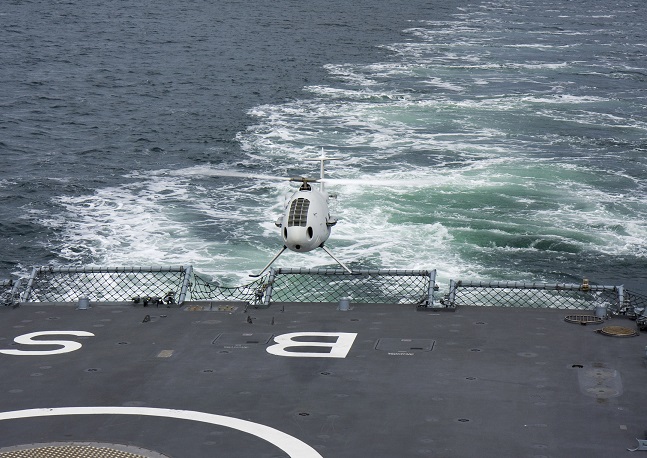
S-100 Shipboard Operations - Image courtesy of Schiebel
The Schiebel S-100 Camcopter is a Vertical Takeoff and Landing (VTOL) UAS in use in several navies. The system has an endurance of over six hours at a speed of 55 knots carrying 75 lbs of payload. The Camcopter's diminutive size and payload makes it ideal for sea-based intelligence, surveillance, and reconnaissance from smaller naval ships such as offshore patrol vessels.
In June 2013, Schiebel announced that it was upgrading the aircraft to integrate maritime radar, electronic support measures (ESM) and EO/IR sensors into the S-100 system.
The UAV flies with the French Navy and possibly China's People Liberation Army-Navy. A variant called the Gorizont Air S-100 produced in Russia under license from Schiebel reportedly serves with the Russian Coast Guard.
Latest News
S-100 UAS Demonstrated to Canadian Coast Guard
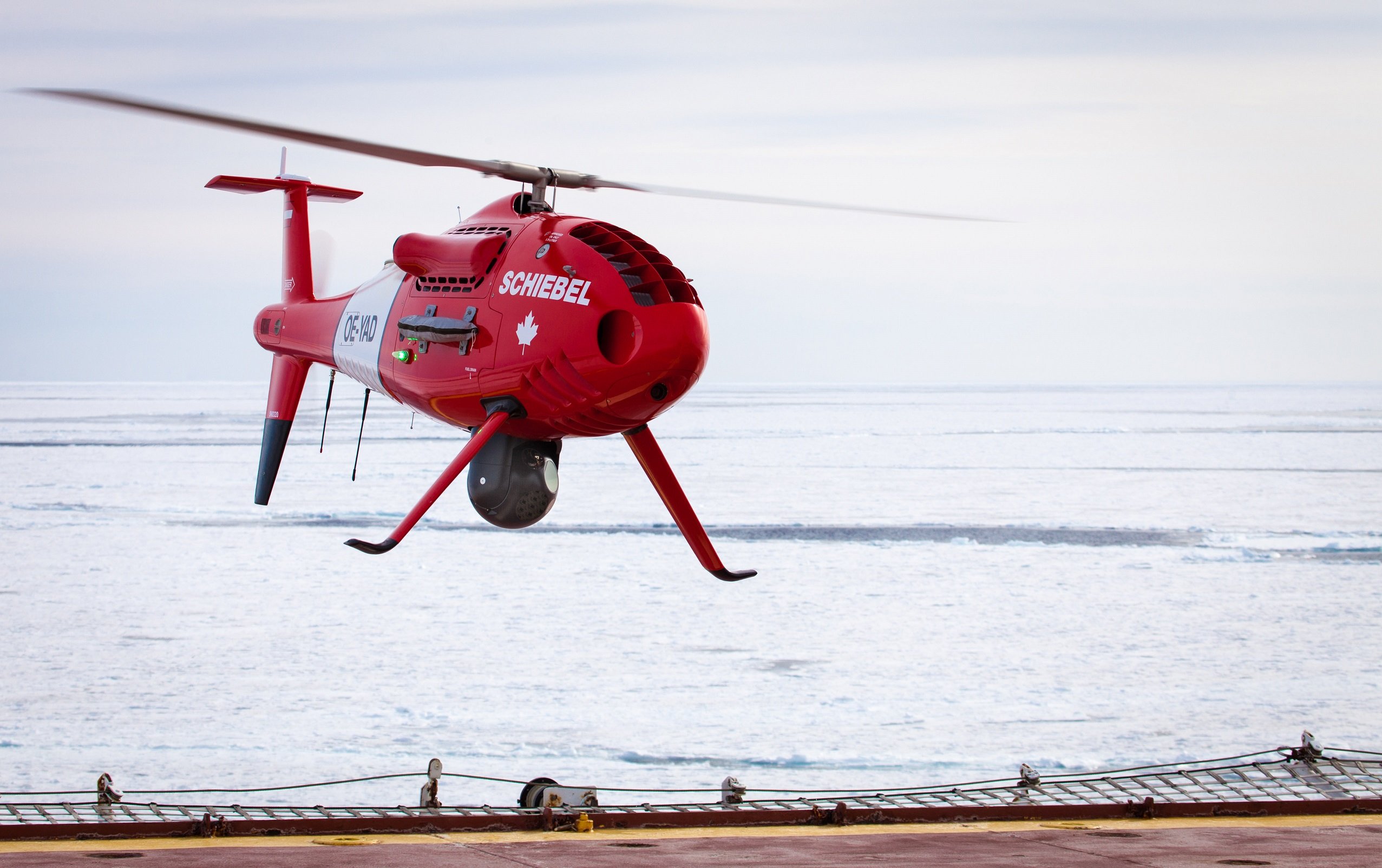
18 April 2016 – Schiebel’s CAMCOPTER® S-100 Unmanned Air System (UAS) successfully
demonstrated its capabilities to a host of dignitaries from the Canadian Coast
Guard, the Royal Canadian Navy, Transport Canada, the Canadian National
Research Council and the University of Alaska in partnership with the Memorial
University of Newfoundland at Fogo Island, Canada.
During trials at the end of March 2016, the CAMCOPTER® S-100, equipped with the Wescam MX-10S payload camera, once again demonstrated its operational value and mission effectiveness in open waters under icy winter conditions. The combination of the VTOL air vehicle and the Wescam MX-10S camera demonstrated its potential to easily identify vessels, animals and objects at long ranges at sea.
“For the Canadian Government this trial is an important step forward to enhancing our operations by using UAV technology”, explains Marc Garneau, Minister of Transport, regarding the motivations for the trials. The CAMCOPTER® S-100 was deployed aboard the CCGS George R. Pearkes, a light icebreaker of the Canadian Coast Guard. About 60 nautical miles north from Fogo Island, the vessel broke through the ice at speeds of up to 14 knots, guided by imagery from the CAMCOPTER® S-100, which offered to the ship’s captain not only a wide view image of the ice structure, but also identified boundaries between flat and rough ice.

Due to the S-100’s operational maturity in the maritime environment and ability to operate in a broad range of weather conditions, it is perfectly suited to support the demands of the Coast Guard. The flight tests included multiple takeoffs and landings in winter conditions. “Once again the CAMCOPTER® S-100 has demonstrated it value, flexibility and suitability for maritime operations in hostile environments”, Chris Day, Head of Capability Engineering at Schiebel, stated.
One goal of the trials was the enhancement of situational awareness by transmitting pictures directly and in real time to the ships bridge. This S-100 feature is already well proven, i.e. in the Mediterranean for humanitarian operations, and is easily adapted to support activities related to the conservation and protection of the Canadian fishing grounds.
UAVs Compete for Dominance in the Arctic
In a press release issued by the Canadian Coast Guard at the time of the trials aboard the CCGS George R. Pearkes, the Canadian Minister of Fisheries, Oceans and the Canadian Coast Guard, Hunter Tootoo was quoted as saying “I am pleased that the Government of Canada is collaborating in this important initiative. The trial is an excellent opportunity to explore UAV technologies for the enhancement of Canadian Coast Guard services.” Likewise Kirsty Duncan, the Canadian Minister of Science, agreed that “Science and research play a central role in our Government’s plan to build a thriving economy, and they provide the evidence the Government needs to make sound policy decisions. By conducting leading-edge trials in real environments, we are better able to understand the impacts, benefits and potential applications of this new technology and ensure that the knowledge we gain is shared with our industry and academic partners.”
CAMCOPTER® S-100 – Flies With Detect and Avoid System
09 February 2016 – Schiebel, the Netherlands Aerospace Centre (NLR), the Netherlands Coastguard, and the Royal Netherlands Air Force conducted a series of successful flights with a newly developed airborne Detect and Avoid System at the airport of Den Helder in December 2015.
The AIRICA (ATM
Innovative RPAS Integration for Coast Guard Applications) project marks a major
step forward in the process of safe integration of RPAS (Remotely Piloted Aircraft
Systems) into all classes of airspace.
During a special demonstration held at De Kooy Airfield in Den Helder, Schiebel provided
it´s unmanned helicopter, the CAMCOPTER® S-100, onto which the NLR developed
AirScout Detect and Avoid System was installed.
The Netherlands Coastguard provided a Dornier Do-228 and the Royal Netherlands Air Force contributed an Alouette helicopter as "intruders,” and provided the Air Traffic Control services. Several scenarios were successfully executed where the CAMCOPTER® S-100 “unexpectedly” encountered an intruder aircraft. The system then determined in real time the corrective action to ensure the necessary separation from the intruder aircraft.
The AIRICA project is funded through the European SESAR programme (part of the Single European Sky initiative) and the key focus – integration of an RPAS into the airspace for Netherlands Coast Guard´s applications – was effectively demonstrated during the flights.
Edwin van der Pol, Head of Operations Kustwacht: ”In the future we hope to use unmanned systems for our search and rescue operations. These trials are important to achieve regulations for bringing RPAS into non-segregated airspace.” Chris Day, Head of Capability Engineering at Schiebel: “This demonstration is another positive step towards unmanned air systems gaining access to a broader range of airspace.”
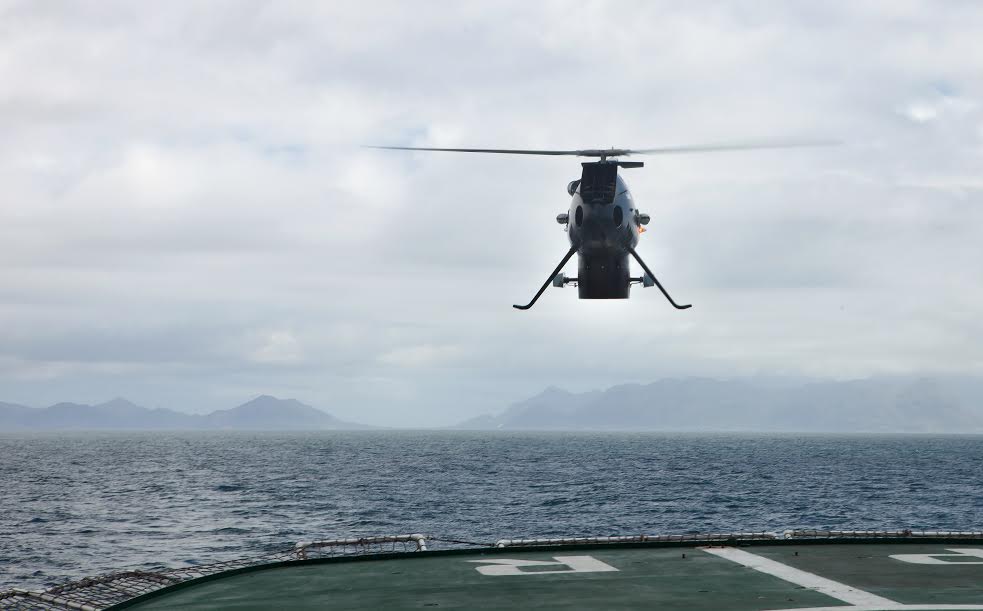
CAMCOPTER® S-100 Completes Trials for the South African Navy
27 October 2015 – Schiebel’s CAMCOPTER® S-100 Unmanned Air System (UAS) continued its successful shipboard trials when demonstrating its capabilities to the South African Navy from 20 to 23 October 2015 at False Bay, Western Cape, South Africa.
The South African Navy as well as a number of delegates from other South African governmental authorities observed the systems' capabilities near Naval Base Simon’s Town. The S-100 conducted all flights from the deck of the SAS Protea, a Hecla class deep ocean hydrographic survey vessel of the South African Navy. Turbulent head and crosswinds beyond 25 knots, limited deck size as well as lack of NATO landing grid represented exceptional challenges during the trials. The unmanned helicopter conducted automatic takeoffs and landings and all other required maneuvers, using its integrated GPS-independent positioning system, enabling pinpoint precision at a high dynamic range.
During the trials the payload of choice was the Selex ES SAGE Electronic Support
Measure (ESM) system, rendering the CAMCOPTER® S-100 capable of detecting,
identifying and geo-locating radio frequency sources while it routinely operates out to
ranges of 200 km or remains on-station for periods of more than 6 hours.
CAMCOPTER® S-100 UAV Assists in Rescue of 8,800 Migrants
2 October 2015 – In five months of operation, the NGO Migrant Offshore Aid Station (MOAS) saved over 8,800 lives in the Mediterranean. By spotting and monitoring distressed vessels, Schiebel’s Unmanned Air System CAMCOPTER® S-100 assisted in the rescue and contributed significantly to the success of the mission.
Thousands of refugees have tragically drowned while crossing the world’s deadliest border. Already back in 2014, MOAS and Schiebel rescued more than 2,800 men, women and children. This year in May the NGO´s Phoenix, a 40-meter long ship, on which the CAMCOPTER® S-100 is stationed, set sail again until the end of September 2015. Under the guidance and coordination of Rome’s Maritime Rescue Coordination Centre it was possible to save over 11,600 lives since the start of the operation in 2014.
The S-100 proved to be a huge asset during the operation as it can locate refugee boats by day and night, even in rough sea conditions and at long distance. The camera of the unmanned helicopter delivers daylight and infrared video in real time to the MOAS team. Due to the high quality of the footage, it is not only possible to locate a small ship even at miles away but also to identify whether it is a fishing boat or a ship in danger.
Operated by Schiebel staff and largely sponsored by Schiebel, the unmanned helicopter serves to considerably extend the reach of the vessel beyond horizon to increase the area of influence. “Schiebel has been supportive from the very beginning in 2014, helping MOAS to become the first civilian organization to use these high-tech helicopters for a great humanitarian purpose. Besides giving us a subsidized rate from the start, Schiebel has generously offered completely free use for the CAMCOPTER® S-100 in part of 2015,” said Martin Xuereb, the MOAS director.
MOAS has significantly reduced the death toll. Even after the end of this year’s Mediterranean
mission, the NGO will continue to monitor the situation closely and plans to resume its operation
next year. Schiebel has provided support since the start of the project and would be happy to join
forces again to prevent deaths at sea whenever possible.
CAMCOPTER S-100 Maritime (MOAS) from Schiebel Group on Vimeo.
Schiebel's S-100 UAV Demonstrated to Royal Australian Navy
16 June 2015 – Schiebel´s CAMCOPTER® S-100 Unmanned Air System (UAS) has in a series of flights between 2 and 12 June 2015 successfully demonstrated its multi- sensor capability to the Royal Australian Navy (RAN) and other Australian Government Departments.
The trials took place near Nowra, on the South East Coast of Australia, and encompassed multiple scenarios, performed during both the day and night. The primary goal was to provide RAN with a comprehensive understanding of how an advanced rotary wing UAS could be effectively used to support maritime and littoral Intelligence Surveillance Reconnaissance (ISR) tasks.
Three mission payloads including the Finmeccanica - Selex ES SAGE ESM, the PicoSAR radar, and the L-3 Wescam MX-10 were operated in realistic maritime security scenarios in the littoral and open ocean. Hans Georg Schiebel Chairman of Schiebel said "This multi-sensor capability of the S-100 is a key element, showing the comprehensive flexibility of our proven system. We feel honored that we were invited by RAN to this demonstration.”
Selex ES highlighted how the combination of the CAMCOPTER® S-100 with their SAGE ESM and PicoSAR radar can extend the surveillance horizon of naval vessels and enhance situational awareness. The data provided by the ESM and radar sensors is crucial to understanding the maritime environment, which was proven in demanding conditions throughout the demonstration.
The CAMCOPTER® S-100 is the only UAS in its class that is able to carry multiple
sensors combined, enabling customers to gather images with an EO/IR camera, to detect
and to identify electronic signatures with a ESM antenna and to use a Synthetic Aperture
Radar (SAR) in real-time with only one system.
Additionally the demonstration allowed RAN personnel to study the pre-flight, operation
and post-flight procedures of the CAMCOPTER® S-100 UAS.
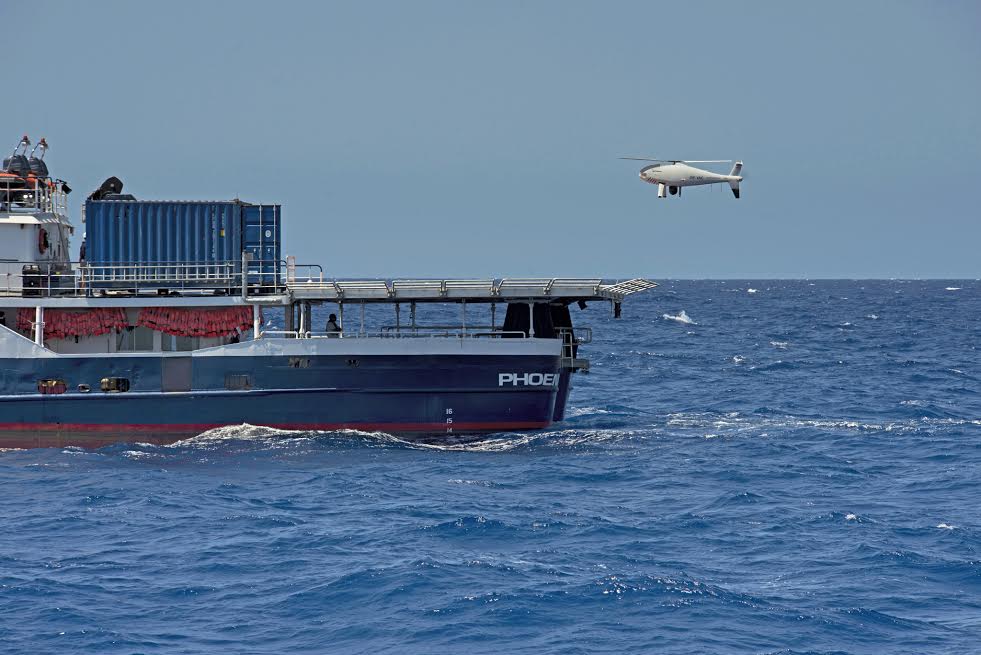
Photo Courtesy Schiebel.
S-100 UAV Helps Save 2,800 Refugees
31 October 2014 - As part of the Migrant Offshore Aid Station (MOAS) operation Schiebel’s CAMCOPTER® S-100 UAS (Unmanned Air System) helped to save the lives of over 2800 refugees in the Mediterranean Sea during several missions.
Between August and October 2014 the expedition vessel Phoenix, carrying the CAMCOPTER® S-100 on board, conducted three operations in the central Mediterranean Sea, each lasting two to three weeks. The final mission of this season was successfully completed on 31st October, saving the life of 331 refugees.
MOAS took the migrants on board, where medical staff provided first aid, blankets, food and water. After that all migrants have been handed over to the Italian Authorities.
Since it began operating, MOAS - with the help of the CAMCOPTER® S-100 UAS - has located and rescued 2851 migrants from distressed boats crossing the Mediterranean Sea.
MOAS is a private NGO initiative to save lives in the Mediterranean Sea, one of the world’s deadliest border crossings. Its aim is to provide assistance at sea in coordination with the Rescue Coordination Centres in the region. A ship-borne aid station, named Phoenix, was made available to support refugee vessels in need. Phoenix has two 6-metre rigid inflatable boats on board that respond to calls for assistance. The CAMCOPTER® S-100 is launched from on board the ship to locate and identify boats in distress. The UAS then provides imagery in real-time, day and night and even under adverse weather conditions. Operated by Schiebel personnel, the EO/IR camera submits essential data to locate people in need. With the help of the unmanned helicopter the Rescue Coordination Centre (RCC) can be informed and provide help immediately.
The mission radius was implemented in a strategic geographic location on the central Mediterranean route, affected by migratory flows departing from the Southern Mediterranean littoral.
See also: NGO Uses Drones for Maritime Rescue
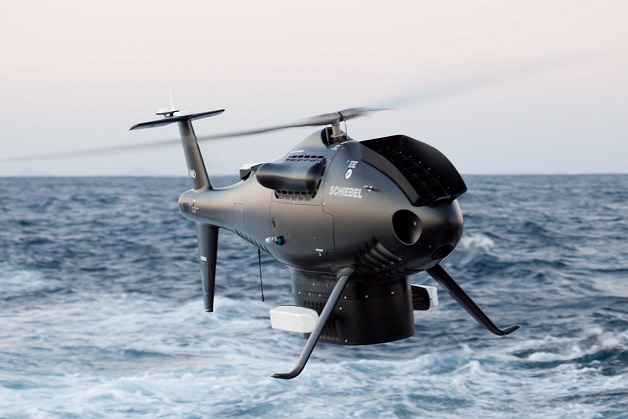
Schiebel Demonstrates the S-100 to the Brazilian Navy
5 June 2014 – Schiebel´s dedication to the maritime domain and its ability to respond to the evolving unmanned systems requirements lead to a series of trials for the Brazilian Navy from 2nd to 5th June near San Pedro, Brazil, from the Brazilian Amazonas Class Ship APA.
Schiebel’s unmanned helicopter CAMCOPTER® S-100 convinced representatives of the Brazilian Navy and Ministry of Defense of its outstanding capabilities as a VTOL UAS (Unmanned Air System), after series of sorties were flown from the sea near San Pedro, Brazil (160 km east from Rio de Janeiro). In support, a number of presentations were given over four days to the attending officers, covering the unique maritime capabilities of the S-100.
The demonstration flights were conducted using scenarios agreed with the Brazilian Navy and designed to evaluate the capabilities of its payloads: L3 Wescam MX-10, Selex ES SAGE ESM, Selex PicoSAR Radar and AIS (Automatic Identification System), highlighting the extensive portfolio of available payloads for the CAMCOPTER® S-100. All trials were carried out during both day and night at ranges out to 44 nautical miles with target detection out to 90 nautical miles.
Italian Navy S-100 Sea Trials
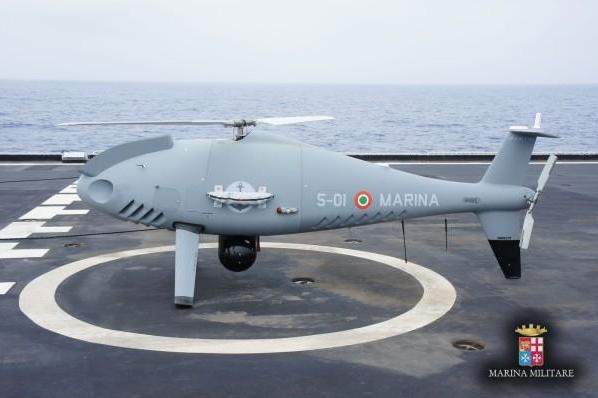
Photo courtesy Italian Navy.
30 May 2014 - Schiebel's S-100 Unmanned Air System is undergoing sea trials with the Italian Navy. Two aircraft and associated control station equipment are on lease to the Italians for interoperability testing aboard the amphibious assault ship ITS San Giusto (L9894).
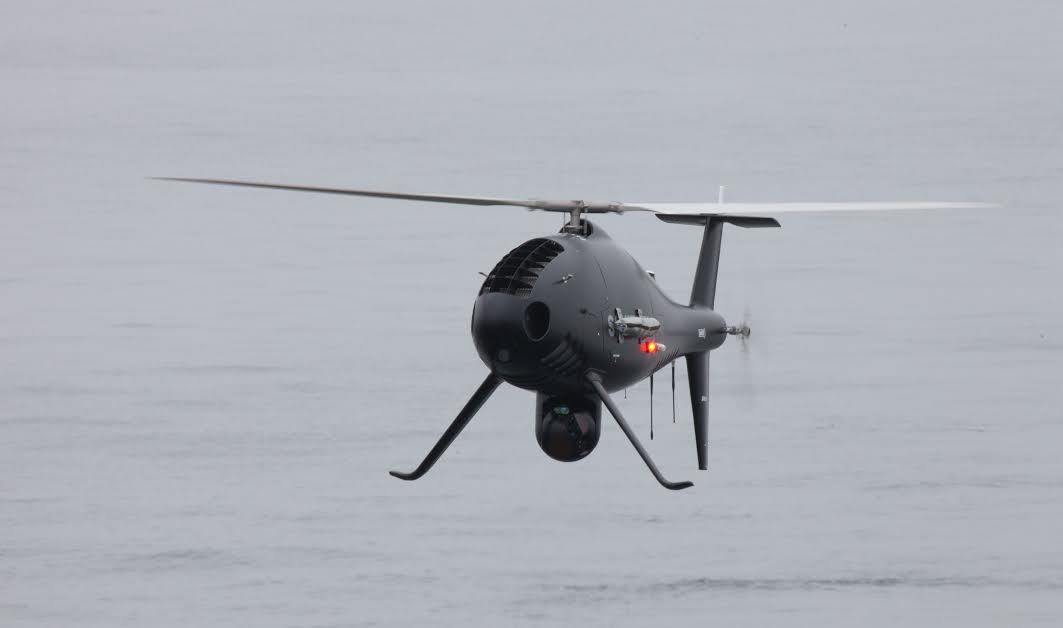
Photo courtesy of Schiebel.
S-100 UAS Demonstrated to Dutch Maritime Authorities
30 April 2014 – Schiebel's CAMCOPTER® S-100 Unmanned Air System (UAS) successfully demonstrated its capability to perform in several different maritime scenarios to Dutch Authorities in Den Helder, The Netherlands, on 29 April 2014.
The S-100 demonstrated its ability to support maritime commanders and decision makers in the North Sea, west of Den Helder. The North Sea is already one of the busiest maritime areas in the world and the Coast Guard expects this to increase over the coming years.
The demonstrations were executed from a Dutch Navy vessel, using the L3 Wescam MX-10 electro-optic sensor as a payload. The demonstration programme was based around a sequence of scenarios commencing with the CAMCOPTER® S-100 introduction to the audience.
In one of those scenarios a fire onboard a ship loaded with dangerous substances resulted in the crew abandoning the vessel, two crew members are missing and no further information is available. Before the rescue mission begins it is deemed essential by the decision makers that they have “eyes” on the target to assess risks and determine the possible location of the missing crew members. The S-100 is deployed to provide this information as well as giving other useful information to help combat the fire. The CAMCOPTER® demonstrated how it can gather this time critical information quickly and efficiently.
Counter-narcotics smuggling formed the theme of another scenario. The S-100 is deployed to discretely follow a suspect vessel. Suddenly a rigid-hulled inflatable boat, (RHIB) appears, moving alongside the vessel. The unmanned helicopter observes and records the transfer of drugs and supplies time critical information to the allied ships to intercept and detain the RHIB.
Hans Georg Schiebel, Chairman of the Schiebel Group of companies noted, ”This series of trials once again showed how the S-100 can provide a cost effective capability to Maritime Commanders and decision makers whether ashore or afloat.”
Italian Navy Awards S-100 Contract
11 February 2014 - Italy's Navy has awarded a contract to Schiebel to acquire a single Camcopter S-100 system, along with associated training, integration, and spare parts. The aircraft was previously demonstrated in April 2012 onboard ITS Bersagliere, a Soldati Class frigate.
Hans Georg Schiebel, Schiebel's chairman, noted that "The Camcopter S-100 continues to be a proven and highly sought after asset in maritime operations. Its ability to extend a ship commander’s visible and electronic horizon to beyond what is conventionally possible is a powerful instrument that helps to counter possible threats, secure routes and control recourses at less operational cost. This quality has already garnered the interest of several global navies where the S-100’s robust nature has proven effective, particularly in the unforgiving maritime environment."
The system will support counter-piracy operations aboard Italian ships in the Indian Ocean.
Selex Flies Electronic Warfare System on S-100
20 December 2013 - Selex ES, a Finmeccanica company, has flown their SAGE electronic warfare system on an unmanned aerial system for the first time. On 12 December, the system flew on-board a Schiebel CAMCOPTER® S-100 UAS in two separate flight trials after an integration period of just two days. Head of Capability Engineering for Schiebel, Chris Day, stated that “The flight trials went very well; the collaboration has been simply outstanding. We now have a unique capability to offer the global market.”
SAGE is a digital Electronic Support Measure (ESM) / Electronic Intelligence (ELINT) system for RF intelligence, surveillance and reconnaissance missions. It enhances situational awareness by passively collecting emitter data from RF sources at a tactically significant range, comparing them with an emitter library and then identifying and geolocating any threats.
Pete Forrest, VP Sales for Electronic Warfare at Selex ES, said: “Armed forces are facing the two-headed challenge of needing to be able to detect increasingly sophisticated RF threats while having to operate under tighter budgets. With SAGE, customers can gain a sophisticated RF detection and geolocation system that they can operate cost-effectively using platforms such as the CAMCOPTER® S-100. We are pleased to be working so effectively with Schiebel and look forward to demonstrations around the world in 2014.”
SAGE is part of Selex ES’s portfolio of advanced electronic warfare capabilities that range from individual sensors to fully integrated defensive aid suites, all backed up by the company’s dedicated Electronic Warfare Operational Support (EWOS) facility. SAGE is in use with the UK MoD and has been provided to the Republic of Korea as part of a package of electronic warfare equipment for the country’s Maritime Operational Helicopter (MOH) program.
Schiebel S-100 – Integrates New FLIR Systems Sensor
5 September 2013 – Schiebel and FLIR Systems Polytec AB announces the successful integration of the Schiebel CAMCOPTER® S-100 Unmanned Air System (UAS) with the CORONA 350 Airborne Sensor. This successful integration marked the first time that this airborne sensor was flown on board a UAV.
The Schiebel CAMCOPTER® S-100 has carried out a series of successful test flights in Grossmittel, Austria, to fully evaluate the combined capability of both systems.
The Corona 350 is a four axis gyro-stabilized gimbal containing four different cameras including an ultraviolet camera for corona detection, a thermal imaging camera for detecting hot-spots in power lines, a visual light camera and a digital frame camera.
What makes the Corona 350 unique is its ability to overlay its ultraviolet and color TV video data to create a combined image that allows operators to detect and identify coronal discharges – areas of ionized air – that are known to damage power line insulators and other electrical components.
The powerful combination of the Schiebel S-100 and the FLIR Corona 350 allows.to carry out aerial inspections quickly and efficiently. Additionally it is the perfect method of reducing costs making it an ideal solution for utility companies to perform inspection and maintenance of transmission lines, distribution networks and substations.
This application typically requires repetitive surveying of power lines and is usually carried out by manned helicopters or ground patrols. The advantage of using the unmanned CAMCOPTER® S-100 UAS over manned helicopters are that the system is uniquely capable of operating without any need for a prepared operating area, with up to 10 hours of endurance and line of site ranges out to 200kms, making the S-100 far more cost-effective than any manned alternative.
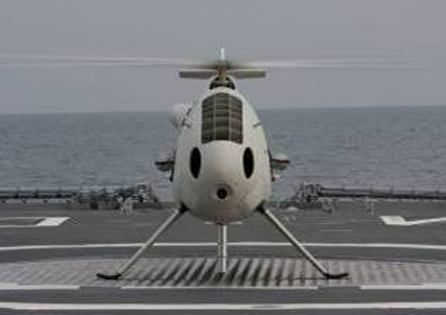 |
China's Expanding Maritime UAS Fleet 18 October 2012 - Recent contract awards indicate further Chinese interest in Unmanned Aerial Systems. |
Video Vault
French Navy conducts S-100 landing qualifications on the Offshore Patrol Vessel L'Adroit.
S-100 operating off German Navy K130 corvettes Braunschweig and Magdeburg in 2008 in the Baltic Sea.